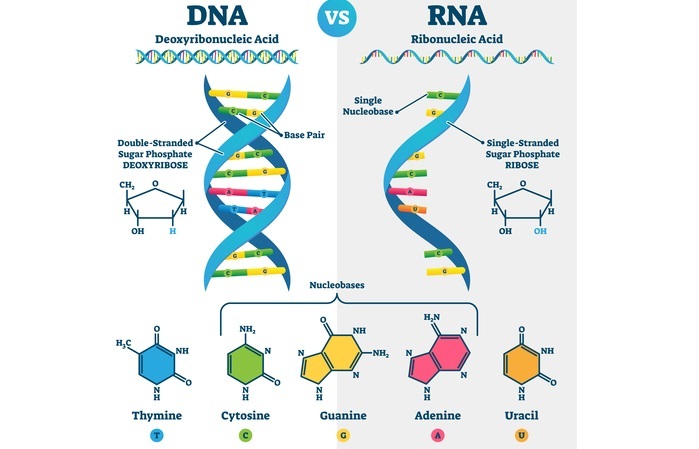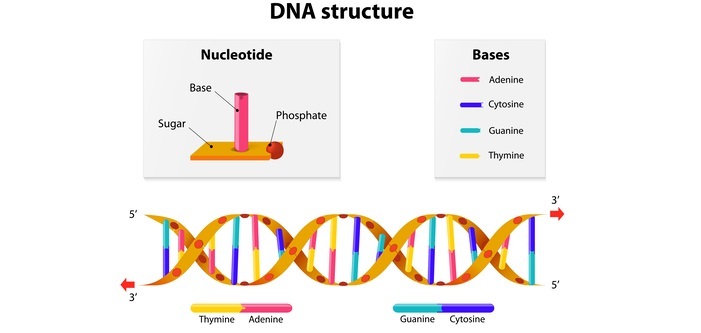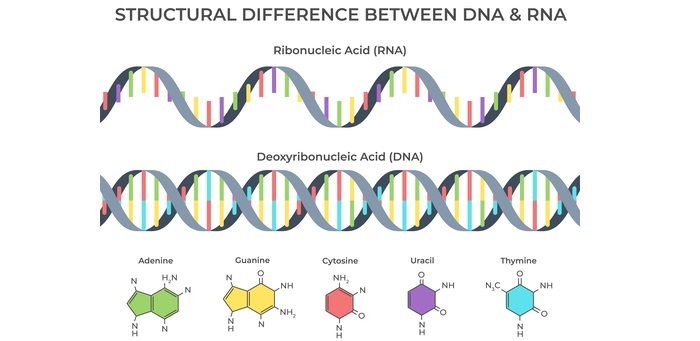
 Data Structure
Data Structure Networking
Networking RDBMS
RDBMS Operating System
Operating System Java
Java MS Excel
MS Excel iOS
iOS HTML
HTML CSS
CSS Android
Android Python
Python C Programming
C Programming C++
C++ C#
C# MongoDB
MongoDB MySQL
MySQL Javascript
Javascript PHP
PHP
- Selected Reading
- UPSC IAS Exams Notes
- Developer's Best Practices
- Questions and Answers
- Effective Resume Writing
- HR Interview Questions
- Computer Glossary
- Who is Who
Differences between DNA and RNA and their Functions
Introduction
Deoxyribonucleic acid (DNA) and ribonucleic acid (RNA) are two essential macromolecules that play crucial roles in storing, transmitting, and expressing genetic information in living organisms. Both DNA and RNA are made up of nucleotides, which are the building blocks of nucleic acids.
However, there are significant differences between DNA and RNA in their structures, and functions. In this article, we will discuss the differences between DNA and RNA, their structures, functions, and why it is important to understand these differences.

What is DNA, the Structure of DNA, and What are the Functions of DNA?
DNA is a double-stranded, helical molecule that contains the genetic information of an organism. It is composed of four types of nucleotides, which are adenine (A), guanine (G), cytosine (C), and thymine (T).
The structure of DNA consists of two polynucleotide chains twisted around each other to form a double helix. The nucleotides are linked together by phosphodiester bonds to form the backbone of the DNA molecule, while the nitrogenous bases are stacked in the interior of the helix.
The functions of DNA are to store and transmit genetic information from one generation to the next. DNA is responsible for controlling the development and functioning of living organisms. It provides the blueprint for the synthesis of proteins, which are essential for the growth, repair, and maintenance of the body.

What is RNA, the Structure of RNA, and What are the Functions of RNA?
RNA is a single-stranded nucleic acid that is composed of four types of nucleotides, which are adenine (A), guanine (G), cytosine (C), and uracil (U). Unlike DNA, RNA contains uracil instead of thymine. RNA has three types, which are messenger RNA (mRNA), transfer RNA (tRNA), and ribosomal RNA (rRNA).
Each type of RNA has a unique structure and function. The structure of RNA consists of a single polynucleotide chain that is folded into a variety of shapes. It contains phosphodiester bonds, like DNA, but the backbone of RNA is ribose instead of deoxyribose.
The nitrogenous bases are exposed on the outside of the molecule, and they form complementary base pairs with DNA or other RNA molecules. The functions of RNA are to carry genetic information from DNA to ribosomes, where it is used to synthesize proteins.
mRNA is responsible for carrying the genetic code from DNA to ribosomes, tRNA is responsible for bringing amino acids to the ribosomes, and rRNA is responsible for making up the ribosomes themselves.
What are the Differences between DNA and RNA and their Functions?
There are several differences between DNA and RNA in their structures and functions.
Structure
DNA is a double-stranded helix, while RNA is a single-stranded molecule.
DNA contains the nitrogenous bases adenine (A), guanine (G), cytosine (C), and thymine (T), while RNA contains adenine (A), guanine (G), cytosine (C), and uracil (U).
DNA contains deoxyribose sugar in its backbone, while RNA contains ribose sugar in its backbone.

Functions
DNA is responsible for storing and transmitting genetic information from one generation to the next, while RNA is responsible for carrying genetic information from DNA to ribosomes, where it is used to synthesize proteins.
DNA is located in the nucleus of eukaryotic cells, while RNA is located in the nucleus and cytoplasm of cells.
DNA replication is a semi-conservative process, where each of the two strands of DNA serves as a template for the synthesis of a new strand. In contrast, RNA replication is not a process that occurs in cells, and RNA is typically synthesized from a DNA template in a process called transcription.
Another important difference between DNA and RNA is that DNA is much more stable than RNA.
DNA is protected by the double-stranded helix structure, which provides a stable structure for the genetic information to be stored.
In contrast, RNA is single-stranded and can be easily degraded by enzymes in the cell. This instability of RNA allows it to be a more dynamic molecule, which can be used to regulate gene expression and respond to changes in the environment.
Why is it Important to Know the Differences between DNA and RNA and their Functions?
Understanding the differences between DNA and RNA is important for several reasons.
First, it allows us to understand how genetic information is stored, transmitted, and expressed in living organisms. This knowledge is essential for the development of new technologies, such as gene editing and gene therapy.
Second, understanding the differences between DNA and RNA can help us understand how mutations and other genetic changes can lead to disease. For example, mutations in DNA can lead to genetic disorders such as cystic fibrosis or sickle cell anemia. Mutations in RNA can also lead to disease, such as in the case of Huntington's disease, where an abnormal RNA molecule causes the disease.
Third, understanding the differences between DNA and RNA is important for understanding the evolution of life on Earth. By comparing the DNA and RNA sequences of different organisms, scientists can determine how closely related they are and how they evolved over time.
Overall, understanding the differences between DNA and RNA is crucial for advancing our knowledge of genetics, evolution, and disease.
FAQs
Q1. Why does DNA have thymine while RNA has uracil?
Ans. Thymine and uracil are both pyrimidine bases, but thymine has an additional methyl group, which makes it more stable than uracil. DNA needs to be more stable because it carries the genetic information of an organism, while RNA is more dynamic and can be easily degraded by enzymes in the cell.
Q2. How does RNA differ from DNA in terms of function?
Ans. DNA is responsible for storing and transmitting genetic information from one generation to the next, while RNA is responsible for carrying genetic information from DNA to ribosomes, where it is used to synthesize proteins.
Q3. What is the difference between the backbone of DNA and RNA?
Ans. The backbone of DNA contains deoxyribose sugar, while the backbone of RNA contains ribose sugar.
Q4. Where is DNA and RNA located in the cell?
Ans. DNA is located in the nucleus of eukaryotic cells, while RNA is located in the nucleus and cytoplasm of cells.

